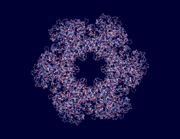Function
Glutamine synthetase (GS) is an essential enzyme in the cellular nitrogen metabolism and has been found to play a role in both ammonia assimilation and glutamine byosynthesis.[1] It is the only enzyme capable of glutamine synthesis and is required for the two step process synthesizing glutamate to glutamine. The glutamine produced is an essential precursor for purine and pyrimidine synthesis, a modulator of protein turnover or an intermediate for gluconeogenesis and acid-base balance. [2]
Structure
The structure of glutamine synthetase is made of two layers, each containing 6 subunits, for a total of 12 subunits. [3] Each subunit contains an which is defined by a cylindrical shape formed by six antiparalel β starnds contributed by one subunit and two more strands by the neighbouring subunit. [3] In each cylindrical active site there are two Mn2+ ions: Mn 2+ 469 and 470. Both are attached to three protein chains and two water molecules, one of the water molecules are shared by both Mn2+. The protein ligands. Attached to Mn 2+ 469 is: Glu-131, GLu-212 and Glu-220, and the protein ligands attached to Mn 2+ are: Glu-129, His-269 and Glu-357.[3]
Unique to glutamine synthetase, unlike other enzymes, is it's "passive site". This refers to the central loop which is formed by a segment of the backbone that extends into the central aqueous cavity. [3]Unlike other sites in glutamine synthetase under the same conditions, this site is suceptible to proteolysis by four secreated proteases from the V8 protease of Staphylococcus aureus.[3]
Additional details in
User:Tom Gluick/Glutamine synthetase
User:Tom Gluick/Human Glutamine Synthetase
User:Tom Gluick/Human Glutamine Synthetase/Large Image Showing Signature with labels
User:Tom Gluick/Human Glutamine Synthetase/Quaternary Structure
User:Tom Gluick/glutamine synthetase
User:Adrian Aldrich/Prokaryotic Glutamine Synthetase Pfam Domains Outline

Figure 1: A clear view of glutamine synthetases "passive site".
Classes
Glutamine synthetase has been described as having three destinctive types:[4]
- Class I (GSI): Genes for this class have only been found in bacteria (eubacteria) and archaea (arhaebacteria. The paper by Kumada et. al goes into detail on these two.[1]. Lengsin is a member of an ancient branch of this family.
- Class II (GSII): Genes for this class have only been found in eukaryotes and a few soil-dwelling bacteria.The paper by Kumada gets into further detail about these bacteria. [1]
- Class III (GSIII): Genes from this class have only been found in a few bacterial species.It is a hexamer of identical chains. It is much larger (about 700 amino acids) than the GSI (450 to 470 amino acids) or GSII (350 to 420 amino acids) enzymes. [4] Brown et. al.(1994) explain in their paper the idea that lateral gene transfer from archeal GSI may have happened and explain the gene mutation.[4]
3D structures of glutamine synthetase
Glutamine synthetase 3D structures

